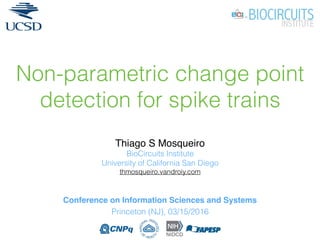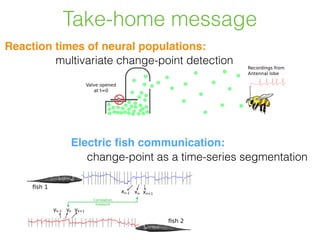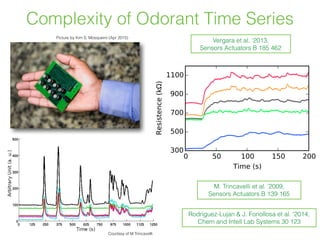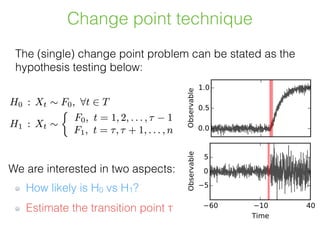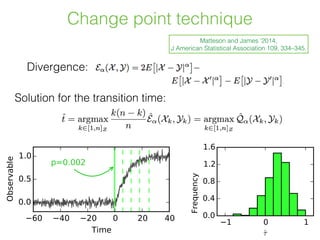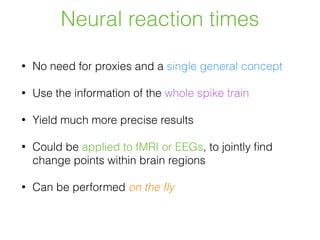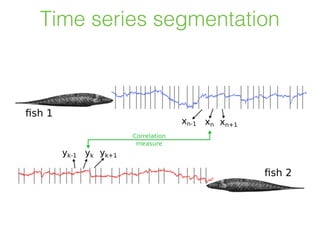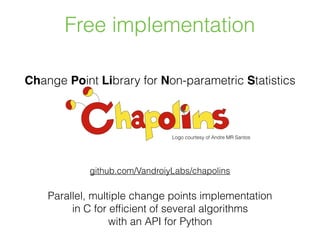Non-parametric Change Point Detection for Spike Trains
- 1. Non-parametric change point detection for spike trains Thiago S Mosqueiro BioCircuits Institute University of California San Diego thmosqueiro.vandroiy.com Conference on Information Sciences and Systems Princeton (NJ), 03/15/2016
- 2. In collaboration with Martin Strube-Bloss Rafael Tuma Reynaldo Pinto Brian Smith Ramon Huerta
- 3. Take-home message Reaction times of neural populations: multivariate change-point detection Electric ’¼üsh communication: change-point as a time-series segmentation
- 4. Complexity of Odorant Time Series Vergara et al. ŌĆś2013, Sensors Actuators B 185 462 M. Trincavelli et al. ŌĆÖ2009, Sensors Actuators B 139 165 Picture by Kim S. Mosqueiro (Apr 2015) Rodriguez-Lujan & J. Fonollosa et al. '2014, Chem and Intell Lab Systems 30 123 Courtesy of M Trincavelli
- 5. Change point technique The (single) change point problem can be stated as the hypothesis testing below: We are interested in two aspects: How likely is H0 vs H1? Estimate the transition point Žä
- 6. Change point technique Divergence: Solution for the transition time: Matteson and James ŌĆś2014, J American Statistical Association 109, 334ŌĆō345.
- 7. Mosqueiro & Maia ŌĆś2012, Phys Rev E 88 012712 Neural systems We know some coding mechanisms In insects, anatomy is well documented Mosqueiro & Huerta ŌĆś2014, Current opinion in insect science
- 8. Main olfactory pathway Mosqueiro, Strube-Bloss, Smith & Huerta, to appearŌĆ”
- 9. Proxy to reaction time Strube-Bloss, et al. ŌĆś2012, PLOS One 7 e50322
- 10. Proxy to reaction time Strube-Bloss, et al. ŌĆś2012, PLOS One 7 e50322
- 11. Using all spike trains ŌĆó To use all spike trains, we get the ’¼ürst 5 components from PCA ŌĆó We then ’¼ünd the change point jointly
- 12. Neural reaction times ŌĆó No need for proxies and a single general concept ŌĆó Use the information of the whole spike train ŌĆó Yield much more precise results ŌĆó Could be applied to fMRI or EEGs, to jointly ’¼ünd change points within brain regionsŌĆ© ŌĆó Can be performed on the ’¼éy
- 13. Pulse-type electric ’¼üsh Forlim & Pinto ŌĆś2014, PLOS One 9 e84885
- 16. Fast time scale ŌĆó Change points are very close (most of time <2s apart) ŌĆó Average of 1.6 symbols / sec ŌĆó To turn it into a symbolic dynamic, we construct features: (variance, avg slope, area under curve, interval duration)
- 17. Clustering of the segments ŌĆó Both ’¼üsh showed similar symbols ŌĆö cue on vocabulary ŌĆó Mutual Information drops after bootstrapping/surrogating Segments showed 3 clusters:
- 18. Clustering of the segments ŌĆó Both ’¼üsh showed similar symbols ŌĆö cue on vocabulary ŌĆó Mutual Information drops after bootstrapping/surrogating Segments showed 3 clusters:
- 19. Cues to Time-series segmentation ŌĆó No need for bins with ’¼üxed sizeŌĆ© ŌĆó Coarser time scale may link to behaviorŌĆ© ŌĆó Clustering symbols seems the same for three different ’¼üsh ŌĆö is there a general vocabulary?ŌĆ© ŌĆó Symbolic dynamics ŌĆö is there a grammar?ŌĆ© ŌĆó Current methods are VERY slow for such number of change points we have a new strategy coming soonŌĆ”
- 20. Free implementation github.com/VandroiyLabs/chapolins Parallel, multiple change points implementation ŌĆ© in C for ef’¼ücient of several algorithms ŌĆ© with an API for Python Logo courtesy of Andre MR Santos Change Point Library for Non-parametric Statistics
- 21. Thanks, everyone, for your attention

